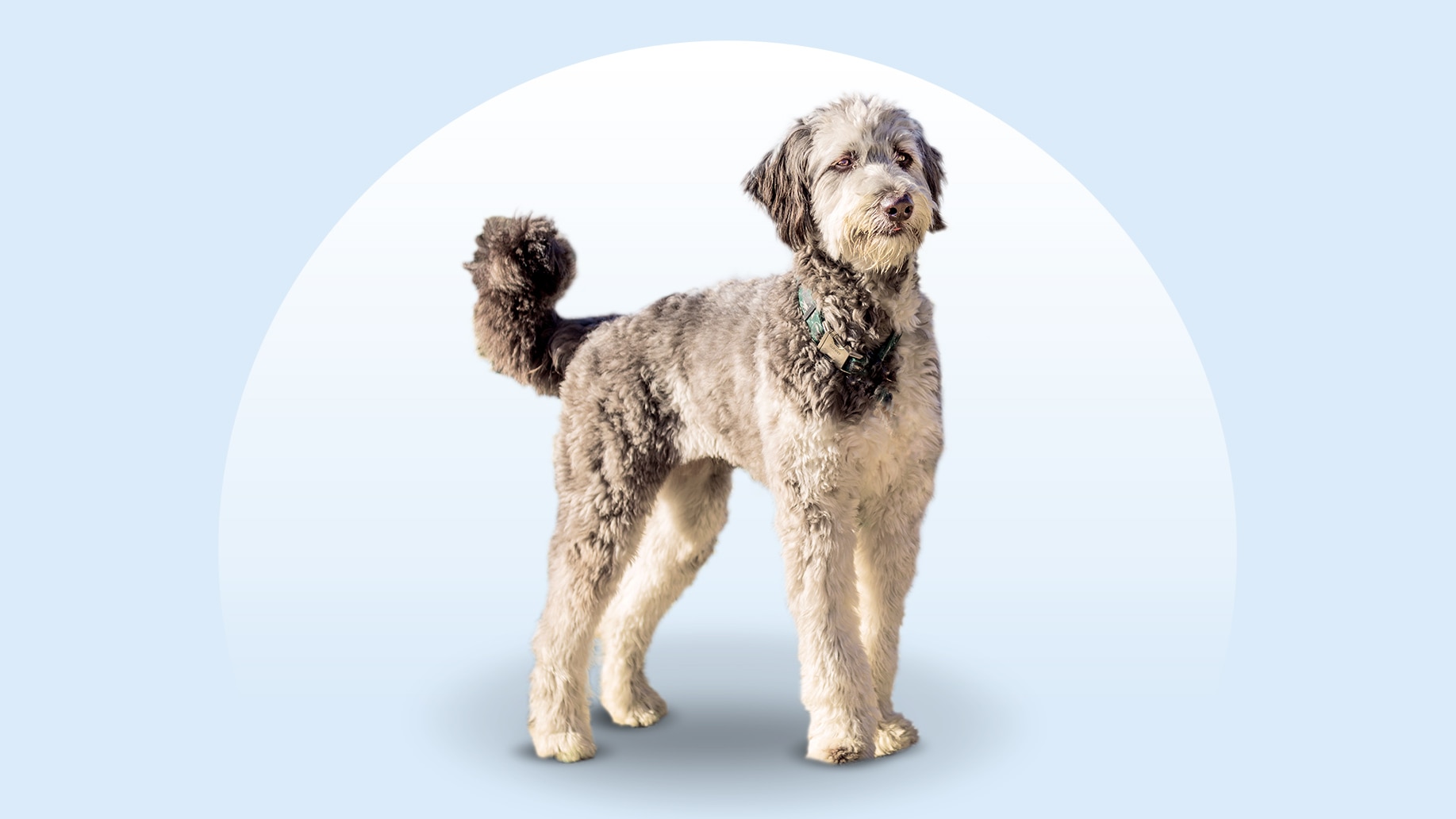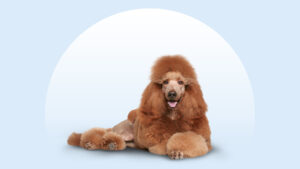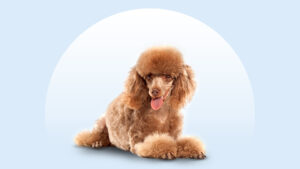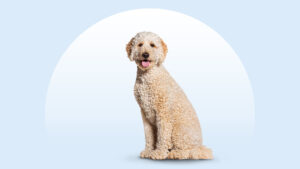Aussiedoodle
Updated June 4, 2025
Aussiedoodle
Updated June 4, 2025
The Aussiedoodle, or Aussiepoo, is the bright, brainy cross between two beloved breeds: the Australian Shepherd and the Poodle. With minds and bodies perpetually primed for action, Aussiedoodles thrive in homes where they can get plenty of physical and mental exercise—and a good brushing afterward.
Canine Einstein, Doggy Dynamo, Star Athlete
Miniature: 15–40 pounds
Standard: 40–70 pounds
Miniature: 10–14 inches
Standard: 15–23 inches
12–15 years
Apricot, Black, Blue, Brown, Cream, Gray, Merle, Red, Silver, White
The Aussiedoodle may sound like a dog from Down Under, but this fun, furry mixed breed is unquestionably tops when it comes to brains, beauty, and athletic ability.
A cross between an Australian Shepherd and a Standard or Miniature Poodle, Aussiedoodles and Mini Aussiedoodles mirror their parent breeds’ love of learning and action. So if you’re looking for a lap dog, keep looking! But if you have an insatiable appetite for exercise and want to add a canine companion on your daily outdoor adventures, the Aussiedoodle just might be your perfect match.
Aussiedoodle Characteristics
Aussiedoodle Appearance
Mixed breeds are always a bit of a mixed bag, as their appearance ultimately depends on which parent they favor. Two Aussiedoodle puppies from the same litter can look wildly different!
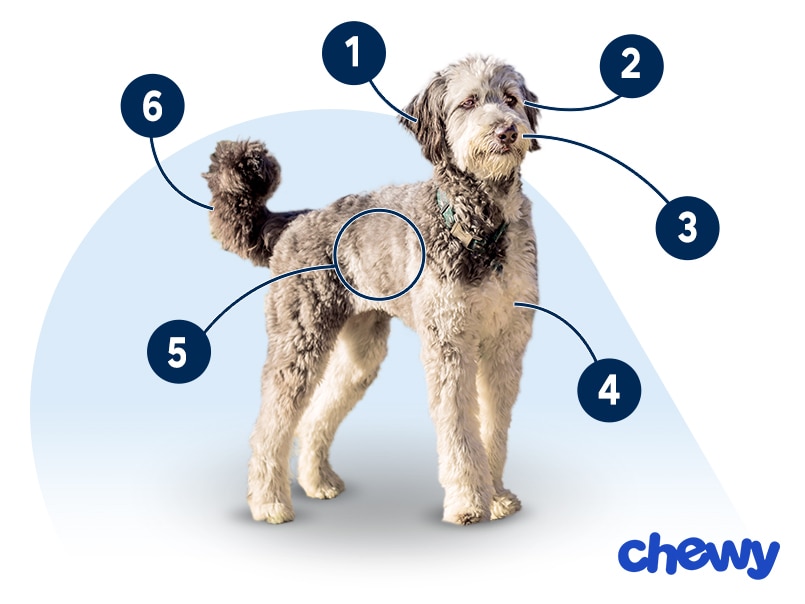
- Ears
Aussies have triangular ears that fold forward from the top of their head, while Poodle ears start at eye level and hang down close to the head. Placement and shape may vary, but Aussiedoodle ears will probably be floppy.
- Eyes
An Aussiedoodle’s eyes can be brown, blue, amber, or a combination of these colors. It’s not uncommon for Aussies to have two different-colored eyes.
- Nose
Aussiedoodles have a straight snout with a black, brown, or pink nose.
- Coat Length
An Aussiedoodle’s coat might be medium or long, wavy or curly, and low-shed or constantly losing fur. It all varies from dog to dog.
- Coat Color
Like length and texture, their coat colors have a wide range and include black, blue, brown, cream, gray, silver, or white. They often have a merle pattern (irregular splotches of color) but can also be bicolor or tricolor.
- Tail
Aussiedoodles often have a tail that’s long and held over the back. Some Aussies are born with bobbed tails, so you might see this in Aussiedoodle puppies, too.
Aussiedoodle Temperament
The Aussiedoodle is a cross of two popular working dog breeds—and they have the temperament to prove it. These are dogs with seriously stellar wits and get-up-and-go energy, making them a top choice for therapy, service, and search-and-rescue roles.
As family pets, Aussiedoodles will still need a “job” in the form of daily exercise and play, and you couldn’t find a more willing companion. The breed excels at agility, swimming, hiking, dock diving, and running.
Because of their herding and hunting instincts, all outdoor play should occur on a leash or within a fenced area. Aussiedoodles are also great with kids who are old enough to safely interact with a high-energy pup—they can entertain each other!
While Aussiedoodles love their families, they can be more reserved around strangers, especially if they take after their Australian Shepherd parent. (This caution served Aussies well as ranch hands!) Early socialization and training can help Aussiedoodles feel more comfortable with their surroundings, thereby reducing the alarm they might sound at something new.
How to Care for a Aussiedoodle
When it comes to caring for Aussiedoodles, there are three main areas to consider: their brain, their body, and their fur.
Grooming
Training
Diet
Exercise
Environment
Aussiedoodle Health
Australian Shepherds typically live 12–15 years, while a Poodle’s life expectancy is 10–18 years. You can expect your Aussiedoodle’s lifespan to fall within this range.
Like all breeds, they can develop certain health conditions:
- Hypothyroidism: Aussies are predisposed to develop autoimmune thyroiditis, a condition in which a dog’s immune system creates inflammation that damages healthy thyroid tissue. It’s the most common cause of hypothyroidism in dogs and can be managed with lifelong medication.
- Sebaceous adenitis: Poodles are prone to an inflammatory skin disease called sebaceous adenitis, which causes hair loss, scaling, dandruff, and secondary skin infections. Treatment depends on the severity but can include medications and antibiotic shampoos.
- Hip and elbow dysplasia: Elbow and hip dysplasia are conditions where a dog’s joints don’t develop properly, leading to pain and arthritis. Mild cases can be managed with anti-inflammatory medication, joint supplements, and weight management. Severe cases may require surgery.
- Bloat: Bloat in dogs occurs when gas and/or food cause the stomach to expand. Sometimes, bloat progresses into a condition called gastric dilatation-volvulus (GDV), in which the dog’s stomach twists and cuts off blood flow to and from the stomach and the spleen. GDV is painful and a life-threatening emergency, and signs include retching or dry heaving without vomiting, swollen abdomen, sudden anxiety, pacing, panting and drooling, and collapse. If you notice any of these signs, get immediate veterinary care.
Aussiedoodle History
The history of the Aussiedoodle begins with a tale of two working breeds.
Despite their geographically misleading moniker, Australian Shepherds trace their heritage to Basque herding dogs called Pyrenean Shepherds. These dogs eventually took their sheep-herding skills to Australia and then to California, where ranchers assumed they’d originated from Down Under and dubbed them Australian Shepherds. Since then, Aussies have become common fixtures in Western culture, including cowboy movies and rodeos.
Poodles have a similarly muddled origin story, because while they may be the national dog of France, the breed was developed in Germany. Poodles got their start retrieving ducks from icy waters hundreds of years ago, but their noble demeanor and elegant appearance helped spur the transition from hunting dog to household companion.
Australian Shepherds became official members of the American Kennel Club (AKC) herding group in 1993, and both Standard and Miniature Poodles joined the AKC’s non-sporting group in 1887.
The Aussiedoodle is a relatively recent mixed breed—likely originating around the 1990s—and isn’t yet a member of the AKC.
